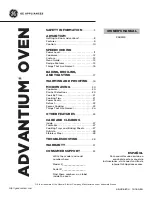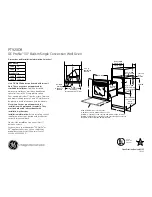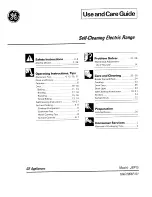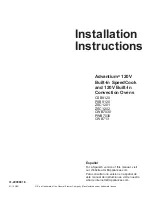
– 4 –
Installation and General Instructions
(continued)
Placement of Oven
1. The oven must be placed on a
fl
at, stable
surface. For correct operation, the oven must
have suf
fi
cient air
fl
ow.
Allow 15 cm of space
on the top of the oven, 10 cm at the back, and
5 cm on both sides. If one side of the oven
is placed
fl
ush to wall, the other side or top
must not be blocked. Do not remove feet.
a. Do not block air vents. If they are blocked
during operation, the oven may be overheated
and damaged. When using any cloth over the
oven, the air intake and exhaust should not be
blocked. Also allow suf
fi
cient space on back
and both sides of the oven.
b. Do not place oven near a hot or damp surface
such as a gas stove, electric range or sink etc.
c. Do not operate oven when room humidity is
too high.
2. This appliance is intended to be used in
household and similar applications such as: staff
kitchen areas in shops, of
fi
ces and other working
environments; farm house; by clients in hotels,
motels and other residential environments; bed
and breakfast type environments.
Building-in your oven
1. This oven is intended for counter-top and built-
in use only. It is not intended for use inside a
cupboard. This oven may be built into a wall
cabinet by using the proper trim kit,
(NN-TK510FSQP/NN-TK510FWQP) which may
be purchased from you local Panasonic dealer.
2. In case of
fi
tting into an oven housing, please use
Panasonic's Trim Kit, NN-TK510FSQP/
NN-TK510FWQP.
3. Microwave ovens should not be built into a unit
directly above a top front venting conventional
cooker. This may be a safety hazard and could
result in damage to your oven. This will invalidate
your one year guarantee.
4. A microwave which is built in must be more
than 850 mm above
fl
oor level. Read Trim-Kit
instructions carefully before installation. It is
recommended that the microwave oven is placed
below a conventional oven to avoid heat damage
to the facia of the microwave.
Circuits
Your microwave oven should be operated on a
separate 10 A circuit from other appliances. Failure
to do this may cause the power board fuse to blow,
and/or food to cook slower. Do not insert higher
value fuse in the power board.
Food
1. Do not use your oven for home canning or the
heating of any closed jar. Pressure will build
up and the jar may explode. In addition, the
microwave oven cannot maintain the food at the
correct canning temperature. Improperly canned
food may spoil and be dangerous to consume.
2. Do not attempt to deep fat fry in your microwave
oven.
3. Do not boil eggs in their shell and whole hard-
boiled eggs (unless otherwise stated in Cooking
Guide section). Pressure will build up and the
eggs will explode.
4. Potatoes, apples, egg yolks, chicken wings,
whole squash and sausages are examples of
foods with nonporous skins. This type of food
must be pierced before cooking, to prevent
bursting.
5. When heating liquids, e.g. soup, sauces and
beverages, in your microwave oven, overheating
the liquid beyond boiling point can occur without
evidence of bubbling. This could result in a
sudden boil over of hot liquid. To prevent this
possibility the following steps should be taken:
a) Avoid using straight-sided containers with
narrow necks.
b) Do not overheat.
c) Stir the liquid before placing the container in
the oven and halfway through cooking time.
d) After heating, allow to stand in the oven for
a short time, stirring again before carefully
removing the container.
6.
DO NOT USE A CONVENTIONAL MEAT
THERMOMETER IN THE MICROWAVE OVEN.
To check the degree of cooking of roasts and
poultry use a MICROWAVE THERMOMETER.
Alternatively, a conventional meat thermometer
may be used after the food is removed from the
oven. If undercooked, return meat or poultry to
the oven and cook for a few more minutes at
the recommended power level. It is important
to ensure that meat and poultry are thoroughly
cooked.
7.
COOKING TIMES given in the Cooking Guide
section are APPROXIMATE.
Factors that may
affect cooking time are preferred degree of
moisture content, starting temperature, altitude,
volume, size, shape of food and utensils used.
As you become familiar with the oven, you will be
able to adjust for these factors.
8.
It is better to UNDERCOOK RATHER THAN
OVERCOOK foods.
If food is undercooked, it
can always be returned to the oven for further
cooking. If food is overcooked, nothing can be
done. Always start with minimum cooking times
recommended.
F0003BN60QP.indb 4
F0003BN60QP.indb 4
2014/8/15 15:23:13
2014/8/15 15:23:13







































